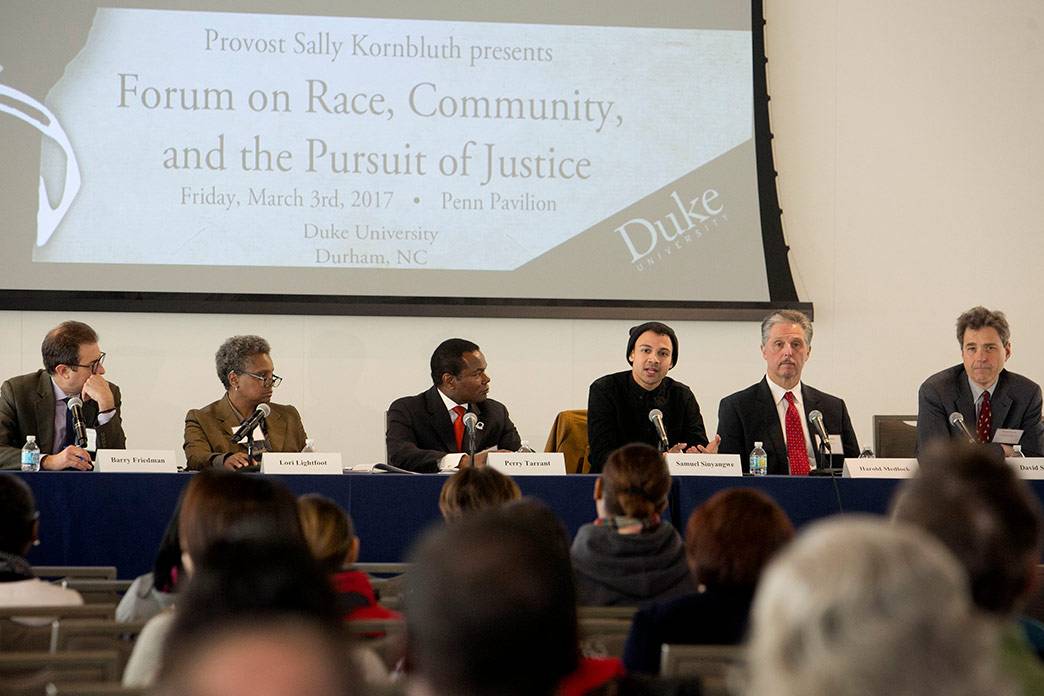Provost's Forum Addresses Rising Tensions in Police-Community Interactions

On Friday, March 3, an audience of nearly 400 came together in Penn Pavilion for a day-long forum on a Forum on Race, Community and the Pursuit of Justice sponsored by Provost Sally Kornbluth. Organized by a steering committee of Duke faculty, the forum addressed topics of mass incarceration of people of color in the United States, police engagement with communities of color, training methods for de-escalation of crises, the demographics of US police forces and the burden placed on police departments to resolve deep rooted social and economic problems.
Activists, artists, scholars, journalists and police officers engaged in dialog about the issues underpinning tensions between law enforcement and marginalized communities and where the country might move forward in resolving these tensions.
Speaking at a session on civilian-police interactions, Chicago activist Lori Lightfoot discussed how the black community in that city suffers both from brutal police interactions and from the rise in violence that followed an apparent retrenchment of police in some of the poorest and dangerous neighborhoods. Lightfoot said change needs to go beyond what is known as “community policing,” but must involve widespread involvement of the community at every level of police work, starting with training.
“We need the police to be armed,” Lightfoot said, “because we have neighborhoods in Chicago that are as violent as war zones. But we want the police to be well trained and taught that their first priority must be to respect the sanctity of life. To do that requires a sea change.
It should be obvious that everyone who lives in a crime-plagued neighborhood is not a criminal, she said, but instead the department sends its youngest and most inexperienced police officers into these communities carrying deep biases and suspicions. They are unable or unwilling to show empathy for the people they serve, she said.
“We need a police that is a respectful, constitutional police,” Lightfoot said. “Too many children learn duck and cover before they learn their ABCs.”
Two police officers raised the burden placed on police departments to resolve deep rooted social and economic problems.
“For the police, one challenge is when a 911 call comes in, that often means all other social systems have failed,” said Assistant Police Chief Perry Tarrant of the Seattle Police Department. “Social services, mental health, the school system. We outfit our police with Narcan pins because we get so many overdose situations. We had 9,300 contacts last year with people in a mental health crisis. In police training, we’re teaching them to deal with a whole bunch of other social failures that lead to situations where officers are expected to solve issues that are beyond their capability to solve.”
Tarrant and retired Fayetteville Police Chief Harold Medlock said police forces are moving away from reliance on recruits with previous military combat experience to a force that more reflects the communities they serve and has skills that are more in line with “police service rather than law enforcement.”
But both admitted departments had a way to go, and activists and scholars presented a wide range of evidence both anecdotal and academic related to racial bias in the criminal justice system, a lack of accountability and a failure by police to connect to local communities.
A leading academic on police violence, David Sklansky of the Stanford Law School said, “it’s not enough to talk about bias in officers. We have to unbias institutions. We need demographic change in these institutions. Ferguson [where an overwhelmingly white police force works in a predominantly black city] is good example. An integrated police force is not a panacea but an important and necessary step.”
Additional sessions covered ideas for justice and reconciliation in police-community relations and possible solutions for community engagement to resolve tensions. On one panel, Michael Brown Sr. and Rolanda Byrd, both parents of young African-American men whose shooting deaths led to protests in Ferguson, Mo., and Raleigh, spoke to the personal trauma of lethal interactions.
Several speakers spoke how smartphones with their video capabilities were changing the narrative. Filmmaker Katina Parker, an instructor at Duke’s Center of Documentary Studies, showed her 20-minute film compiled from video and audio footage of a series of lethal interactions between police and young black men.
Including Trayvon Martin, Keith Scott in Charlotte, Alton Sterling in Louisiana, Tamir Rice in Cleveland and Eric Garner in New York, the horrific footage showed the last moments of these people’s lives. But while the videos bring national attention, Parker said the they still aren’t bringing justice, nor are they changing an implicit bias against young black men.
“When black children are killed there is a burden of proof that black parents must prove their children’s innocence to the media and the police,” Parker said. “You have to prove they were worthy of their lives when they were killed.”
The day’s fifth and final session was on Constructing Solutions. Panelists from the New York Police Department, some of the nation’s top law schools and the largest online racial justice organization closed the meeting by providing audience members with opportunities for real-life actions to bring change in their communities.